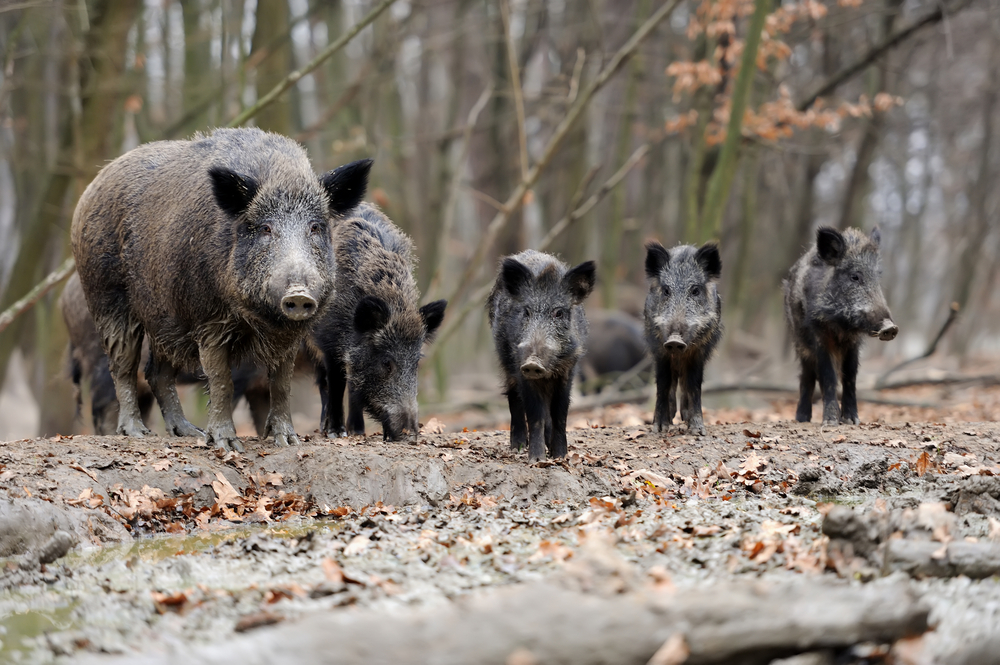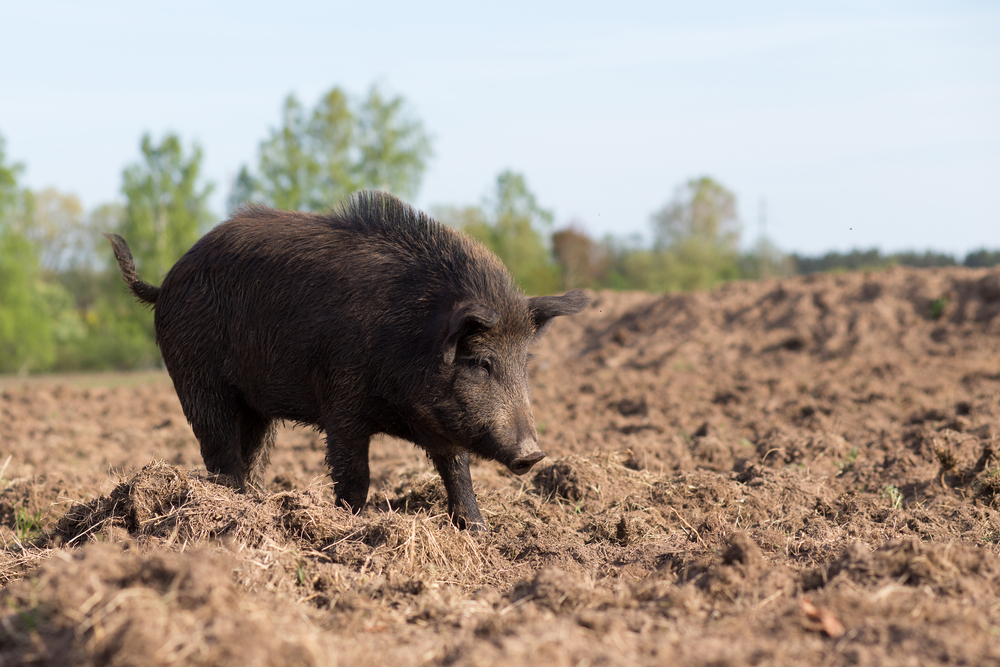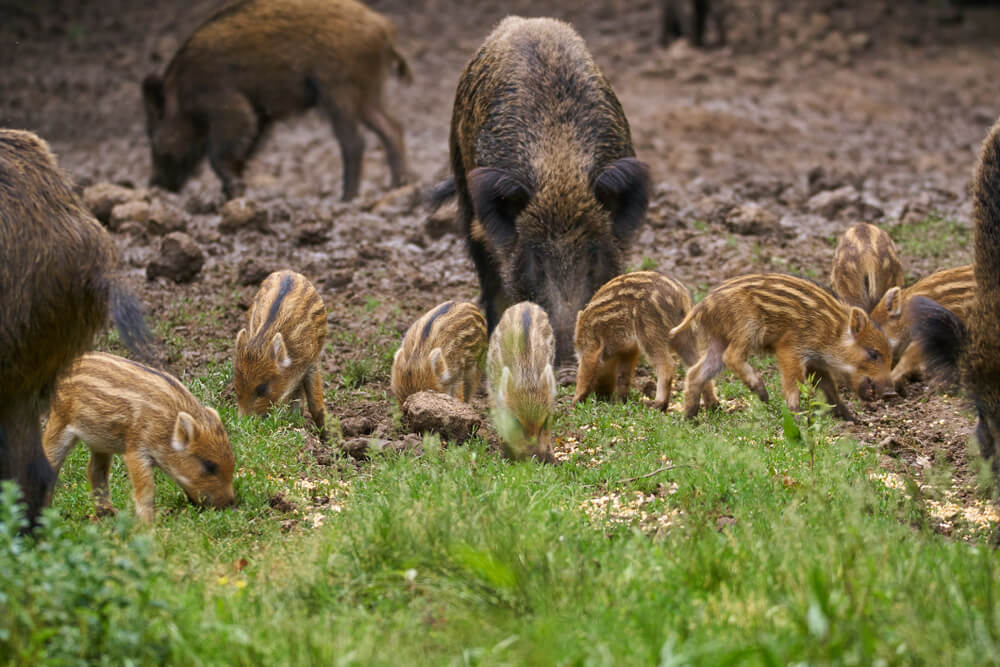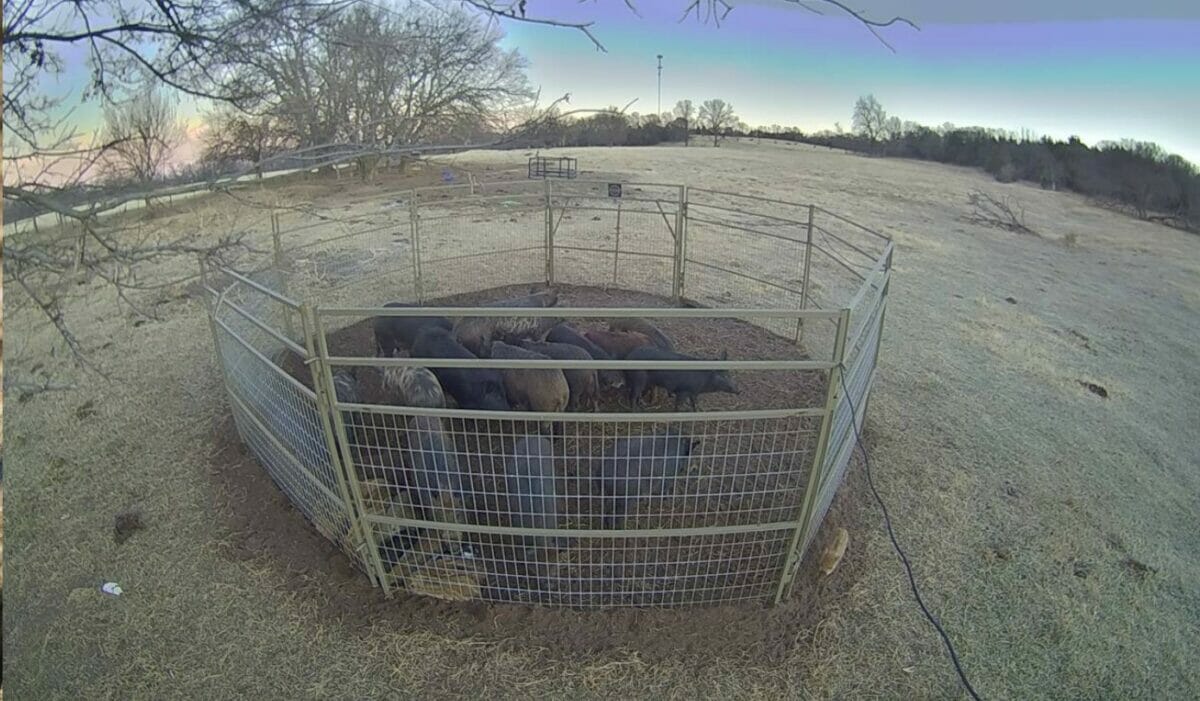What Will It Take to Tackle America’s Feral Hog Problem?
There are differing views about what to do about wild pig populations, known for rooting up fields and disrupting farm ecosystems.
What Will It Take to Tackle America’s Feral Hog Problem?
There are differing views about what to do about wild pig populations, known for rooting up fields and disrupting farm ecosystems.

Wild pigs leave a path of destruction in their wake.by Volodymyr Burdiak, Shutterstock.
Josh Ritchey has become accustomed to seeing craters and ruts strewn across his fields—signs of unwelcome visitors on his Stephenville, Texas farm. Often, before harvest time rolls around, a good portion of his wheat and hay crop have been plowed over or rooted up. The culprit? Drifts of feral swine that demolish anything in their path.
“They’re very opportunistic. They can sniff a crop out right before it’s ready to harvest,” Ritchey says. “Sometimes, I feel like I’m fighting an inferno with a water pistol…There’s always more back a month later.”
In recent years, the fourth-generation farmer says feral swine have contributed to a 10-percent annual loss in his crops. He’s heard of neighboring producers that have lost up to 30 percent of their yields.

Ritchey, who is also a realtor, believes a big reason why farmers and ranchers haven’t seen any improvements is due to the enthusiasm for hunting feral hogs as a sport. In Texas, they’re one of few animals aside from quail that can be hunted year-round, supporting the state’s multi-billion-dollar sport hunting industry.
“When I’m selling property, one of the first questions I hear is ‘are there pigs?’ and ‘I want it if it has pigs,’” he says. “Many landowners are protective of them and are happy to let them stay on their property.”
The infestation of wild pigs is not specific to the Lone Star State. Across the country, voices in agriculture and conservation say feral swine have increasingly posed a threat by tearing up fields, scarfing down crops and polluting water—causing an economic fallout among producers and potentially passing on diseases or parasites to other animals or humans. Some scientific studies have even calculated that, annually, when droves of feral hogs tear up the ground across the globe, they release the carbon trapped in the soil that’s equivalent to 1.1 million cars.
Recent estimates say there are anywhere from 6.5 million to 9 million feral hogs across at least 30 states, which carry a price tag of anywhere from $1.5 billion to $2.5 billion in damages and control. The USDA has referred to the phenomenon as “the feral swine bomb.”
But wild pigs weren’t always viewed as pests. During the 16th century, feral swine were brought to the United States by colonizers as a source of food. Then, in the 1900s, the Eurasian or Russian wild boar was introduced into parts of the country for the purpose of sport hunting. Today, these animals, identified by their barrel-shaped bodies, pointy snouts and beady eyes, are a combination of escaped domestic pigs, Eurasian wild boars or hybrids of the two.
Now, the pests terrorize farmers, ranchers and even suburbanites. There are differing views, however, on what the best approach is to tackling the issue—as well as whether the growing populations are even a problem at all.
Farmers and ranchers want wild hogs gone for good. Hunters want to keep enough of their population around for their leisure. Some see the issue of feral swine as a long game that will take years to address. Others believe it needs to be solved urgently, and they want the government to cough up the cash in order to do so.
There’s also a lack of a consensus on state and federal intervention as some feel states should carve out their own approach. California, for instance, is in the process of introducing new legislation that would create greater opportunities to hunt the animals as a management tactic. Yet others argue that blanket measures would be most effective.

Reginald Barrett, professor emeritus at University of California, Berkeley’s Department of Environmental Science, Policy and Management, has studied wild hogs since 1966. Wild hogs have a short gestation period, can produce two litters a year and can give birth to up to 10 piglets at a time. In order to see any meaningful reduction in their numbers, Barrett says that roughly 70 percent of the population would need to be killed off each year. These calculations are based on prior research in Queensland, Australia, where he documented swine growing at a rate of one pig per square mile to 100 pigs per square mile in three years.
“I considered writing a paper early on in my career called ‘the pigs are coming, the pigs are coming,’ but never got it done,” he says. “I figured at that point they were probably here to stay.”
Instead of focusing on the threat of their arrival, Barrett shifted parts of his research to focus on how to effectively manage and best eradicate feral swine. With any pests, including wild pigs, Barrett says, the best and cheapest way to get rid of them is to do it as quickly as possible. However, this often involves paying a hefty price tag upfront, which some governments are not willing to do. As a point of reference, the cost of aerial gunning on California’s Channel Islands alone, Barrett says, racked up about $250,000 per island over the span of six months.
Barrett cites a success story on Santa Cruz Island from June 1989 to January 1991, when the Nature Conservancy was able to eradicate its population of pigs by using a variety of methods such as aerial hunting in helicopters, trapping and hunting with dogs. If you aren’t on an island, he adds, it’s best you build a wire mesh fence that prevents the pigs from leaving or returning.
“They will readily disperse,” he says. “You can hit them hard in one place, but you know, unless you’re going to be watching them every day, you’re going to be back in the pig business before you know it.”
Feral hogs’ brazen destruction has captured the attention of the federal government since 2014. A spokesperson from the USDA says the agency acted “in response to the increasing damage and threats posed by expanding feral swine populations in the United States” through creating the National Feral Swine Damage Management Program that same year. The $20 million earmarked for the program sought to eliminate populations, protect agriculture and natural resources as well as animal and human health. It was led by the Animal and Plant Health Inspection Service (APHIS), which worked with other federal agencies, states, Indigenous groups, local organizations and universities to establish specific approaches.
The USDA credits this program to eliminating hogs from Washington, Colorado, Minnesota, Wisconsin, Iowa, Vermont, Idaho, Maine, New Jersey, Maryland and New York, although it’s worth noting that these are states where sport hunting the animals isn’t as widely pursued as in more southern states.
A new pilot program aims to eradicate wild pig populations. Formally known as the Feral Swine Eradication and Control Pilot Program (FSCP), it’s a joint effort between the USDA’s Natural Resources Conservation Service (NRCS) and APHIS. The program was established as a result of the 2018 Farm Bill “to respond to the threat feral swine pose to agriculture, native ecosystems, and human and animal health.”
Since 2020, the FSCP has existed to support states with the highest recorded hog populations. The USDA is working with Auburn University and Texas A&M to assess damage caused by feral swine before, during and after their removal across all participating states. This includes Texas along with Alabama, Arkansas, Florida, Georgia, Louisiana, Mississippi, Oklahoma, North Carolina and South Carolina. Total funding for the program is $75 million for the life of the 2018 Farm Bill and is divided evenly between the APHIS and NRCS. The initiative’s three components consist of feral swine removal by APHIS, restoration efforts supported by NRCS and assistance to producers for feral swine control provided through grants with non-federal partners.
“The strategy is two-fold,” says a USDA spokesperson. “First, we are working to eliminate feral swine in states where populations are low or newly emerging; and second, we are reducing feral swine numbers to minimize damage in states where populations are large and widely distributed. Through these efforts, APHIS protects agricultural and natural resources, property, animal health and human health and safety by reducing feral swine damage through a co-ordinated national effort.”
As a participant in the program, Ritchey—based in Erath County, Texas (population 42,698)—shares six electronic traps between farmers, ranchers and landowners who want to rid the animals from their area. His county has been able to harvest about 300 pigs in the past seven months.
In Oklahoma, Trey Lam, executive director of the Oklahoma Conservation Commission, oversees his state’s participation in the pilot program. To date, it has purchased 25 electronic traps that can be operated remotely—10 of which are shared among three counties and 15 shared among six counties in Oklahoma’s southwest region. There are no fences being used as a trapping measure, but APHIS personnel have been trying to hunt the hogs from helicopters for roughly six months. The state has also made an effort to collaborate with neighboring Texas around its border.

“We’re trying our best to assess the damage and capture these animals,” says Lam. “The greatest fear, and certainly the greatest fear from the swine industry, is that [infectious diseases such as] brucellosis or pseudorabies that affect swine so badly will be transmitted over into domestic animals.”
From June to December 2021, Oklahoma was able to kill 4,139 hogs in the state’s Osage Pawnee, Red River and Upper Red River regions. But Lam says the commission has been fielding requests from those outside of the counties of focus, speaking to the need for more resources.
“I know of local farmers and ranchers who are making crop decisions and changing rotations based on how much they can avoid hogs,” he says. “From a conservation point of view, it’s really thrown a wrench in our approach to improving state soil through no till.”
He echoed Ritchey’s comments about the sport hunting industry, stating that people often transport a number of hogs to an area of their choosing for hunting and then leave them to reproduce. But, generally, Lam believes the pilot program has foundational value in creating a broader approach to effectively tackle wild pig numbers. He remains hopeful that the situation will be resolved in the future.
Ritchey is less optimistic. He believes there needs to be a blanket approach executed across the country, as well as more political will on the part of the federal government to drown out the sport hunting industry. For the time being, he’ll continue to keep his feet in both worlds—selling property to handfuls of aspiring hog hunters while engaging in what seems to him like a never-ending game of whack a mole.
Follow us
This work is licensed under a Creative Commons Attribution-NoDerivatives 4.0 International License.
Want to republish a Modern Farmer story?
We are happy for Modern Farmer stories to be shared, and encourage you to republish our articles for your audience. When doing so, we ask that you follow these guidelines:
Please credit us and our writers
For the author byline, please use “Author Name, Modern Farmer.” At the top of our stories, if on the web, please include this text and link: “This story was originally published by Modern Farmer.”
Please make sure to include a link back to either our home page or the article URL.
At the bottom of the story, please include the following text:
“Modern Farmer is a nonprofit initiative dedicated to raising awareness and catalyzing action at the intersection of food, agriculture, and society. Read more at <link>Modern Farmer</link>.”
Use our widget
We’d like to be able to track our stories, so we ask that if you republish our content, you do so using our widget (located on the left hand side of the article). The HTML code has a built-in tracker that tells us the data and domain where the story was published, as well as view counts.
Check the image requirements
It’s your responsibility to confirm you're licensed to republish images in our articles. Some images, such as those from commercial providers, don't allow their images to be republished without permission or payment. Copyright terms are generally listed in the image caption and attribution. You are welcome to omit our images or substitute with your own. Charts and interactive graphics follow the same rules.
Don’t change too much. Or, ask us first.
Articles must be republished in their entirety. It’s okay to change references to time (“today” to “yesterday”) or location (“Iowa City, IA” to “here”). But please keep everything else the same.
If you feel strongly that a more material edit needs to be made, get in touch with us at [email protected]. We’re happy to discuss it with the original author, but we must have prior approval for changes before publication.
Special cases
Extracts. You may run the first few lines or paragraphs of the article and then say: “Read the full article at Modern Farmer” with a link back to the original article.
Quotes. You may quote authors provided you include a link back to the article URL.
Translations. These require writer approval. To inquire about translation of a Modern Farmer article, contact us at [email protected]
Signed consent / copyright release forms. These are not required, provided you are following these guidelines.
Print. Articles can be republished in print under these same rules, with the exception that you do not need to include the links.
Tag us
When sharing the story on social media, please tag us using the following: - Twitter (@ModFarm) - Facebook (@ModernFarmerMedia) - Instagram (@modfarm)
Use our content respectfully
Modern Farmer is a nonprofit and as such we share our content for free and in good faith in order to reach new audiences. Respectfully,
No selling ads against our stories. It’s okay to put our stories on pages with ads.
Don’t republish our material wholesale, or automatically; you need to select stories to be republished individually.
You have no rights to sell, license, syndicate, or otherwise represent yourself as the authorized owner of our material to any third parties. This means that you cannot actively publish or submit our work for syndication to third party platforms or apps like Apple News or Google News. We understand that publishers cannot fully control when certain third parties automatically summarize or crawl content from publishers’ own sites.
Keep in touch
We want to hear from you if you love Modern Farmer content, have a collaboration idea, or anything else to share. As a nonprofit outlet, we work in service of our community and are always open to comments, feedback, and ideas. Contact us at [email protected].by Lindsay Campbell, Modern Farmer
February 16, 2022
Modern Farmer Weekly
Solutions Hub
Innovations, ideas and inspiration. Actionable solutions for a resilient food system.
ExploreExplore other topics
Share With Us
We want to hear from Modern Farmer readers who have thoughtful commentary, actionable solutions, or helpful ideas to share.
SubmitNecessary cookies are absolutely essential for the website to function properly. This category only includes cookies that ensures basic functionalities and security features of the website. These cookies do not store any personal information.
Any cookies that may not be particularly necessary for the website to function and are used specifically to collect user personal data via analytics, ads, other embedded contents are termed as non-necessary cookies.
Bring back the wolves.
Quite a mess. Landowners should be able to kill every feral hog they find on their property, perhaps even get a bounty.
when we moved here there was a wild hog problem then they were gone, thankfully someone shot them all. now 6 years later there back OMG there digging up our hay field, its a mess big holes they dig and lay in they come in the early morning hours as my dog alerts me and i get the spotlight and there they are. just want them gone permanently. San Antonio TX area
You have to do an industrial approach to this issue, trap and place location collar on a few pigs, send in hunter teams with dogs, have a portable processing plant on site. The proceeds from the meat alone would finance the operation, plus there are grants from the gov. totaling to 75 million.
Make it profitable
Years ago I asked the game warden from Texas why it is that they do not simply open feral hog up to for-profit hunting, so that a person could shoot a hog and then sell the meat that a profit.
FDA wont allow the meat to be sold. If they did, there would be hunters likiting the herds to more manageable levels
Feral hogs have few prefators. But humans could br
i personally, love the pigs. i think that they should be able to roam around like they did in ancient times. they have been here longer than us. let’s leave the land to them. perhaps even have them take over our society!! 🐗❤️